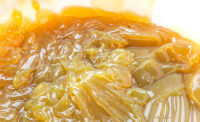Machine lubrication is crucial if meat and poultry processors are to sustain operating efficiencies and maximize revenues. Yet it is an element many plant managers neglect.
If operators do not follow appropriate lubrication procedures, analysts say, they are putting valuable assets at risk. Following appropriate procedures includes using the optimal types of greases and oils, adhering to application schedules and dispensing the proper amounts of lubrication.
“Thirty percent of all equipment breakdowns are because of poor lubrication,” says Doc Palmer, managing partner of Richard Palmer and Associates Inc., an Ellijay, Ga.-based maintenance planning and scheduling firm. “Lubricating bearings is one of the most critical tasks in plants. Yet companies often give the job to inexperienced junior mechanics.”
Upper management is frequently blind to the benefits from frequent lubrication, Palmer notes, with many operators viewing the practice as a burdensome expense rather than an investment in operations.
“Lubricating is crucial and every dollar spent for proper machine maintenance saves a company $10 on the bottom line by avoiding equipment breakdowns,” he says. “Good maintenance practices can increase plant capacity and eliminate the need to install extra processing lines. It is almost a way for processors to make money for free.”
To garner the greatest benefits from lubrication, however, plant operators must properly train workers on the appropriate maintenance techniques, says John Crossan, a Downers Grove, Ill.-based manufacturing and maintenance consultant. “It is important to spell out the procedures for employees,” he says.
Possible missteps, Crossan notes, include damaging apparatus by spraying lubricants directly into bearings with too much force; not reapplying the same amount of lubrication that is lost during high pressure and steam cleanings; using the wrong grade of lubricants; putting too much grease into bearings, leading to overheating; not properly cleaning the tips of grease guns, which can result in the injecting of dirt into machinery; and contaminating lubricants through improper storage.
Buy-in is big
Ensuring workers adhere to proper practices, however, requires that they also have input in the formulation of maintenance guidelines, Crossan says. “Engineers and managers think they can just write the procedures down and the employees will automatically follow the specifications; but people don’t work that way,” he notes. “… Giving them a feeling of ownership increases the chances that the employees will use the procedures on an ongoing basis.”
Plant personnel can most effectively perform lube maintenance by using checklists and having co-workers periodically audit their techniques, Crossan notes.
“Appropriate training is the key,” he says. “It is essential to make sure that the people handling lubrication know what they are doing. Processors should not give the job to inexperienced personnel.”
In addition, many meat and poultry plant operators must adopt a new mindset if proper lubrication is to become a standard operating procedure, says Peter McLiverty, chair of the Chicago chapter of the Society of Maintenance and Reliability Professionals (SMRP).
“There is a very easy payback for those operators who fix the lubrication issues in their facilities, but many still do not properly deal with the problem,” he says. “It often is a matter of ‘out of sight, out of mind.’ But the returns are so effortless that it is amazing that more plant managers don’t focus on the practice. It definitely gets overlooked.”
Even managers who support robust lubrication are frequently mishandling the operation, McLiverty notes. That includes spending more time and energy choosing suppliers and products than developing and implementing sound application procedures and educating workers on the methods, he says.
“The lube guys usually receive the lowest pay in plants and often are in entry-level positions,” McLiverty states. “There is very little training that goes with that.” NP





Report Abusive Comment